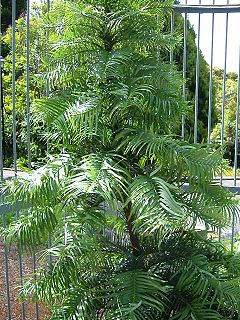Wollemia
|
Wollemia Temporal range: Jurassic to recent 200–0 Ma |
|
|---|---|
 |
|
| Young specimen in a botanical garden protected from theft by a steel cage | |
| Scientific classification | |
| Kingdom: | Plantae |
| Division: | Pinophyta |
| Class: | Pinopsida |
| Order: | Pinales |
| Family: | Araucariaceae |
| Genus: | Wollemia |
| Species: | W. nobilis |
| Binomial name | |
|
Wollemia nobilis W.G.Jones, K.D.Hill & J.M.Allen |
|
Wollemia is a genus of coniferous tree in the family Araucariaceae. Wollemia was only known through fossil records until the Australian species Wollemia nobilis was discovered in 1994 in a temperate rainforest wilderness area of the Wollemi National Park in New South Wales, in a remote series of narrow, steep-sided sandstone gorges 150 km north-west of Sydney. The genus is named for the National Park.
In both botanical and popular literature the tree has been almost universally referred to as the Wollemi pine, although it is not a true pine (genus Pinus) nor a member of the pine family (Pinaceae), but rather is related to Agathis and Araucaria in the family Araucariaceae. The oldest fossil of the Wollemi tree has been dated to 200 million years ago.
The Wollemi pine is classified as Critically Endangered (CR) on the IUCN's Red List, and is legally protected in Australia. A Recovery Plan has been drawn up, outlining strategies for the management of this fragile population; the overall objective is to ensure that this species remains viable in the long-term.
Wollemia nobilis is an evergreen tree reaching 25–40 m (82–131 ft) tall. The bark is very distinctive, dark brown and knobbly, quoted as resembling Coco Pops breakfast cereal. The tree coppices readily, and most specimens are multiple-trunked or appear as clumps of trunks thought to derive from old coppice growth, with some consisting of up to 100 stems of differing sizes. The branching is unique in that nearly all the side branches never have further branching. After a few years, each branch either terminates in a cone (either male or female) or ceases growth. After this, or when the cone becomes mature, the branch dies. New branches then arise from dormant buds on the main trunk. Rarely, a side branch will turn erect and develop into a secondary trunk, which then bears a new set of side branches.
...
Wikipedia

